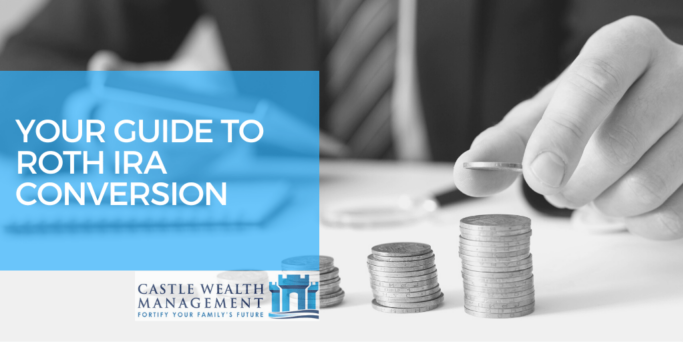Individual Retirement Accounts (IRA) are one of the most popular retirement savings vehicles available for a good reason. They offer tax-deferred growth on your investment earnings and, in some cases (like a Roth IRA), tax-free withdrawals in retirement.
But what if you're not sure whether a Roth IRA is right for you? Or what if you have a traditional IRA and you're thinking about converting it to a Roth IRA?
In this article, we'll explore the concept of a Roth IRA conversion and provide some guidance on whether it's something you should consider. Topics we'll cover include:
- What is a Roth IRA?
- What is a Roth Conversion?
- Roth vs Traditional IRA: Key Differences
- When should you convert to a Roth IRA?
- Who should NOT convert to a Roth IRA?
- How to convert to a Roth IRA
Let's get into it. Here's everything you need to know about Roth IRA conversions in 2023.
What is a Roth IRA?
A Roth IRA is a type of retirement account that allows you to contribute after-tax dollars. This means that you won't get a tax deduction for your contributions, but all future withdrawals will be tax-free.
Roth IRAs are popular because they offer tax-free growth and tax-free withdrawals in retirement. This can be a great way to reduce your tax bill in retirement.
What is a Roth Conversion?
A Roth conversion is simply the process of converting a traditional IRA into a Roth IRA. This can be done by transferring the money from your traditional IRA into a Roth IRA account. We'll get more detailed later when we talk about how to convert.
Roth vs Traditional IRA: Key Differences
There are a few critical differences between Roth IRAs and traditional IRAs that you should be aware of before you decide to convert.
- Roth IRAs offer tax-free growth and tax-free withdrawals in retirement.
- Traditional IRAs offer tax-deferred growth and taxed withdrawals in retirement.
- Roth IRAs have no required minimum distributions (RMDs) for the account owner.
- Traditional IRAs do have RMDs. This means that you can leave your money in a Roth IRA for as long as you want, but you must start withdrawing from a traditional IRA at age 73 in 2023 and moving marginally later until age 75 under the Secure Act 2.0.
- If you withdraw your money from your traditional IRA before the age of 59 1/2, you'll probably not only be required to pay the taxes on it, but you may have to pay an additional penalty of 10% for early withdrawal unless you take withdrawals as substantially equal periodic payments.
- With a Roth IRA, you can withdraw your contributions before age 59 1/2 with no penalty and tax-free, as long as you have had a Roth account for at least five years.
There are a few extenuating circumstances where early withdrawal from a traditional IRA may not be penalized. The main ones include:
- having a temporary or permanent disability
- death where the money is withdrawn by a beneficiary
- use of $10,000 of the funds for a first-time home purchase for self or child
- post-secondary higher education needs of self, spouse, or child
- Health insurance premiums with unemployment and certain high medical expenses
When Should You Convert to a Roth IRA?
If you're thinking about converting to a Roth IRA, here are a few key scenarios where it would be beneficial.
If you're in a low tax bracket now but expect to be in a higher one in retirement, it may make sense to convert to a Roth IRA and pay the taxes at your current lower rate. This is especially true if you're younger and have a longer time horizon until retirement.
Another circumstance where converting to a Roth IRA may make sense is if you have a traditional IRA with a lot of money and are worried about the RMDs. By converting to a Roth IRA, you can avoid having to take RMDs and keep your money invested for longer.
A Roth is also a good idea if you don't plan to use the money for your own retirement, but instead you'd like to pass it on to beneficiaries in the future. While those beneficiaries will have to take RMDs, they won’t have to pay taxes on them. That is a nice gift to your heirs!
Who Should NOT Convert to a Roth IRA?
Converting to a Roth IRA isn't right for everyone. There are a few circumstances where you may want to think twice before converting.
If you're in a high tax bracket now and expect to be in a lower one in retirement, it may not make sense to convert to a Roth IRA. You'll pay taxes at your current high rate, and then when you withdraw the money in retirement, you'll be in a lower tax bracket and won't get the full benefit of the conversion.
Another circumstance where converting may not make sense is if the income generated from the traditional IRA distribution would push you into a higher tax bracket. You'll have to pay taxes on the money you convert at your current marginal tax rate. If that additional income pushes your marginal tax rate higher, doing the conversion probably doesn’t make sense.
Finally, if you're close to retirement, it may not make sense to convert to a Roth IRA. This is because you won't have as much time for the money to grow tax-free and you'll have to pay taxes on the conversion right before retirement. Rather, it often makes sense to do a conversion right after you retire and before you have to take RMDs from your traditional IRA. This is often when your income is much lower than it has been historically or will be in the future.
How to Convert a Traditional IRA to a Roth IRA
Now that we've discussed when you should (and shouldn't) convert to a Roth IRA, let's talk about how to actually do it.
The process of converting is actually pretty simple. You just need to contact your traditional IRA custodian and tell them that you want to do a Roth conversion.
You'll then need to fill out some paperwork and arrange to have the money or specific securities you pick transferred from your traditional IRA to your Roth IRA. You will also need to indicate how much federal and state income tax you want withheld, if any.
There are three ways to do this and rules to follow:
- A rollover, in which a check gets deposited to your Roth within 60 days.
- A trustee-to-trustee transfer, in which the exchange goes through two financial institutions.
- A same-trustee transfer, which is the same institution holding the traditional IRA account, then transferring cash or securities into a Roth IRA account at the same firm.
You'll have to pay taxes on the money you convert at your current marginal tax rate, but other than that, there are no penalties or fees associated with converting. You’ll also need to report conversions to the IRS, which a trusted advisor can help you with.
Once the money is in your Roth IRA, it will grow tax-free and you'll not have to take any RMDs under the current tax laws.
The Bottom Line
Converting to a Roth IRA can be a great way to save for retirement, but it's not right for everyone.
Be sure to consider your current and future tax situation before making the decision to convert, because an important thing to remember is that you cannot "undo" a conversion. So once you've made this choice, it's final.
If you have any questions about whether converting to a Roth IRA is right for you, be sure to speak with a trusted financial advisor like Castle Wealth Management. We can help you run the numbers and make the best decision for your unique circumstances to build you a better future.

